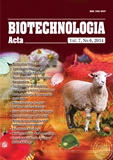ISSN 2410-7751 (Print)
ISSN 2410-776X (Online)

"Biotechnologia Acta" v. 7, no 6, 2014
https://doi.org/10.15407/biotech7.06.023
Р. 23-28, Bibliography 11, Russian
Universal Decimal classification: 577.158.54
THE THERMAL INACTIVATION OF Eupenicillium erubescens α-L-RHAMNOSIDASE
O. V. Gudzenko, N. V. Borzova, L. D. Varbanets
Zabolotny Institute of Microbiology and Virology
of the National Academy of Sciences of Ukraine, Kiev, Ukraine
The study of the features of thermal inactivation of α-L-rhamnosidase from Eupenicillium erubescens aiming to develop further strategies for improving the stability of the enzyme was the purpose of the research. Two forms of α-L-rhamnosidases were studied. They were obtained by producer cultivation on two different carbon sources (rhamnose and naringin). It was shown that at temperatures above 60 0C heat inactivation process is described by the first order reaction kinetics. It was established that stability of α-L-rhamnosidase from E. erubescen, grown on naringin depends on hydrophobic interactions rather than electrostatic ones. It was shown that aggregation of enzyme molecules could lead to their thermal stabilization. The important role of cysteine residues and possible involvement of the metal cation in maintaining of active form of α-L-rhamnosidases from E. erubescens was highlighted.
Key words: Eupenicillium erubescens, α-Lrhamnosidase, thermal inactivation, naringin, rhamnose.
© Palladin Institute of Biochemistry of the National Academy of Sciences of Ukraine, 2014
References
1. Yadav V., Yadav P. K., Yadav S., Yadav K. D. S. ?LRhamnosidase: A review. Proc. Biochem. 2010, 45 (8), 1226–1235.
http://dx.doi.org/10.1016/j.procbio.2010.05.025
2. Yadav S., Yadav V., Yadav S., Yadav K. D. S. Purification, characterisation and application of ?Lrhamnosidase from Penicillium citrinum MTCC8897. Int. J. Food Sci. Technol. 2012, 47 (2), 290–298.
http://dx.doi.org/10.1111/j.1365-2621.2011.02838.x
3. Puri M. Updates on naringinase: structural and biotechnological aspects. Appl. Microb. Biotechnol. 2012, 93 (1), 49–60.
http://dx.doi.org/10.1007/s00253-011-3679-3
4. Varbanets L. D., Gudzenko O. V., Borzova N. V. Rhamnosidase from Eupenicillium erubescens: purification and characterization. Nauka i studia. 2013, 41 (109), 11–23.
5. Soria F., Ellenrieder G. Thermal inactivation and product inhibition of Aspergillus terreus CECT 2663 ?Lrhamnosidase and their role on hydrolysis of naringin solutions Biosci. Biotechnol. Biochem. 2002, 66 (7), 1442–1449.
http://dx.doi.org/10.1271/bbb.66.1442
6. Davis D. W. Determination of flavonones in citrus juice. Anal. Biochem. 1947, 19 (1), 46–48.
7. Lowry O. H., Rosebrough N. J., Farr A. L., Randall R. J. Protein measurement with Folin phenol reagent. J. Biol. Chem. 1951, 193 (2), 265–275.
8. Lakin G. F. Biometrics. Moskva: Vysshaia shkola. 1990, 325 p. (In Russian).
9. Santos A., Ladero M., GarciaOchoa F. Kinetic modeling of lactose hydrolysis by ?galactosidase from Kluyveromyces fragilis. Enz. Microb. Technol. 1998, 22 (8), 558–567.
http://dx.doi.org/10.1016/S0141-0229(97)00236-6
10. Poltorak O. M., Chukhray E. S., Torshin I. Yu. Dissociative thermoinactivation, stability and activity of olygomeric enzymes. Biokhimiia. 1998, 63(3), 360–369. (In Russian).
11. Kurganov B. I. Kinetics of heat aggregation of proteins. Biokhimiia. 1998, 63 (3), 430–432. (In Russian).

